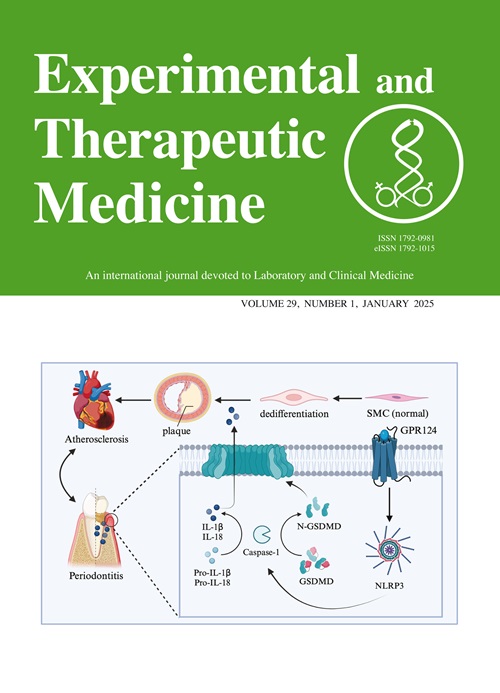Risk factors for post‑retrograde cholangiopancreatography pancreatitis in patients with common bile duct stones: A meta‑analysis.
IF 2.3
4区 医学
Q3 MEDICINE, RESEARCH & EXPERIMENTAL
引用次数: 0
Abstract
Endoscopic retrograde cholangiopancreatography (ERCP) has become a common treatment method for common bile duct stones. However, ERCP is also associated with a high risk of post-endoscopic retrograde cholangiopancreatography pancreatitis (PEP). Identification of risk factors is essential for reducing the incidence of PEP. The present study aimed to summarize the risk factors for PEP by performing a meta-analysis. Therefore, studies published between 2000 and 2022 were screened in PubMed, Cochrane Library, Embase, Web of Science, China National Knowledge Infrastructure, Wanfang Digital Periodicals and the Weipu Database, with no language restrictions. Newcastle-Ottawa Scale was used to assess the quality of the included studies. Stata 17.0 software was utilized for the meta-analysis of 14 possible risk factors. Overall, 15 high-quality studies were included into the present meta-analysis. The results showed that female [odds ratio (OR), 1.42; 95% CI, 1.23-1.64), age <60 years (OR, 1.53; 95% CI, 1.06-2.21), difficult intubation (OR, 4.87; 95% CI, 2.73-8.68), ≥3 cannulation attempts (OR, 9.64; 95% CI, 4.16-22.35), cannulation time ≥10 min (OR, 2.37; 95% CI, 1.67-3.35), history of pancreatitis (OR, 2.95; 95% CI, 1.06-5.51), pancreatic duct visualization (OR, 3.63; 95% CI, 2.47-5.34) and sphincter of Oddi dysfunction (OR, 5.72; 95% CI, 1.80-18.24) are potential risk factors for PEP (P<0.05). In conclusion, the present meta-analysis suggests that PEP can be affected by several risk factors, particularly the technique-related factors such as the frequency and time of cannulation. Therefore, effective precautions should be taken as early as possible to reduce the incidence of PEP.胆总管结石患者逆行胰胆管造影术后胰腺炎的风险因素:荟萃分析。
内镜逆行胰胆管造影术(ERCP)已成为治疗胆总管结石的常用方法。然而,ERCP 也与内镜逆行胰胆管造影术后胰腺炎(PEP)的高风险相关。识别风险因素对于降低 PEP 的发生率至关重要。本研究旨在通过荟萃分析总结 PEP 的风险因素。因此,本研究在 PubMed、Cochrane Library、Embase、Web of Science、中国国家知识基础设施、万方数字期刊和维普数据库中筛选了 2000 年至 2022 年间发表的研究,语言不限。采用纽卡斯尔-渥太华量表评估纳入研究的质量。使用 Stata 17.0 软件对 14 个可能的风险因素进行了荟萃分析。本次荟萃分析共纳入了 15 项高质量研究。结果显示,女性[几率比(OR),1.42;95% CI,1.23-1.64]、年龄<60 岁(OR,1.53;95% CI,1.06-2.21)、插管困难(OR,4.87;95% CI,2.73-8.68)、插管尝试≥3 次(OR,9.64;95% CI,4.16-22.35)、插管时间≥10 分钟(OR,2.37;95% CI,1.67-3.35)、胰腺炎病史(OR,2.95;95% CI,1.06-5.51)、胰管可视化(OR,3.63;95% CI,2.47-5.34)和 Oddi括约肌功能障碍(OR,5.72;95% CI,1.80-18.24)是 PEP 的潜在危险因素(P<0.05)。总之,本荟萃分析表明,PEP 可受多种风险因素的影响,尤其是与插管频率和时间等技术相关的因素。因此,应尽早采取有效的预防措施以降低 PEP 的发生率。
本文章由计算机程序翻译,如有差异,请以英文原文为准。
求助全文
约1分钟内获得全文
求助全文
来源期刊

Experimental and therapeutic medicine
MEDICINE, RESEARCH & EXPERIMENTAL-
CiteScore
1.50
自引率
0.00%
发文量
570
审稿时长
1 months
期刊介绍:
 求助内容:
求助内容: 应助结果提醒方式:
应助结果提醒方式:


